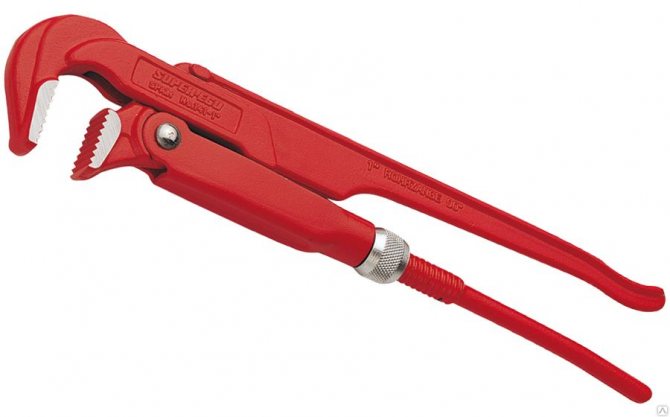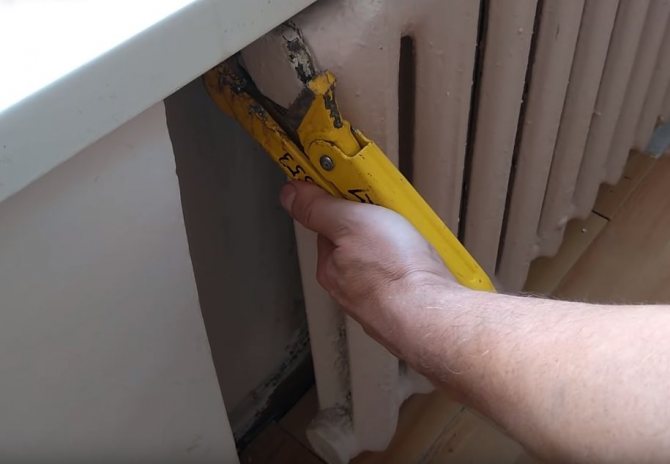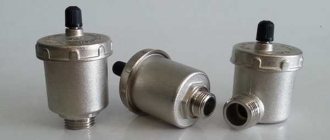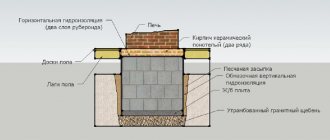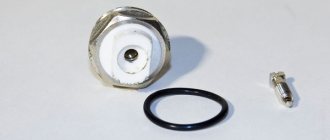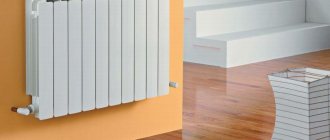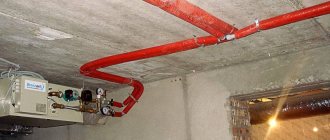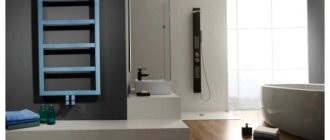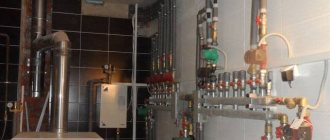How to avoid air congestion
The sequence of preventive measures depends on the type of heating system.
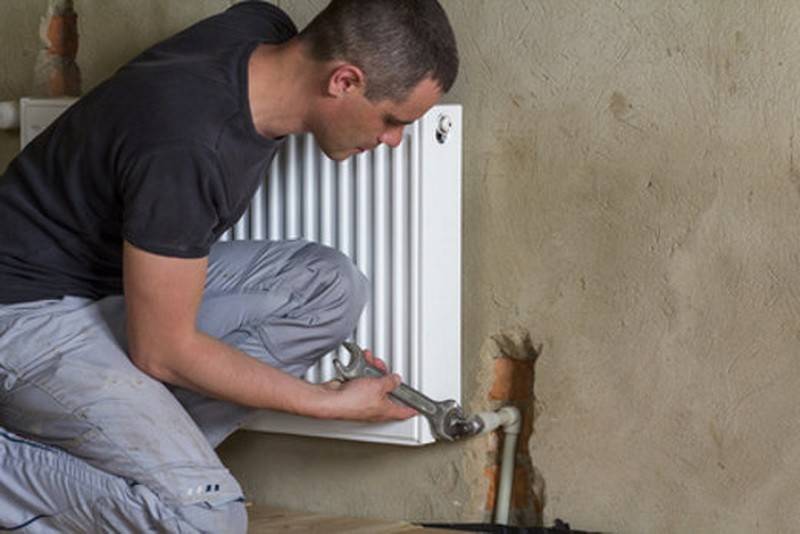
Open circuit
A system of this type is filled with hot water on its own. All valves on radiators must be open to allow unobstructed water access. It is necessary to monitor the force of pressure and not to allow too strong and rapid filling. Close the drain valve when filling the empty space of the batteries.
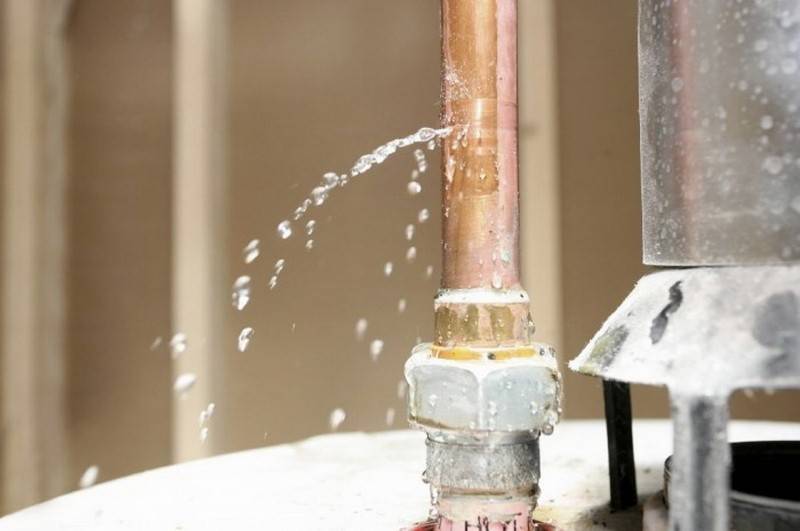

Filling closed systems
The steps to complete this type of system differ from the standards. On the contrary, the valves are primarily closed. Only the one through which water is poured into the system is left open. Then a pump is connected to ensure a stable pressure in the pipes. The air from the batteries is released using taps only after the entire system is filled with water.
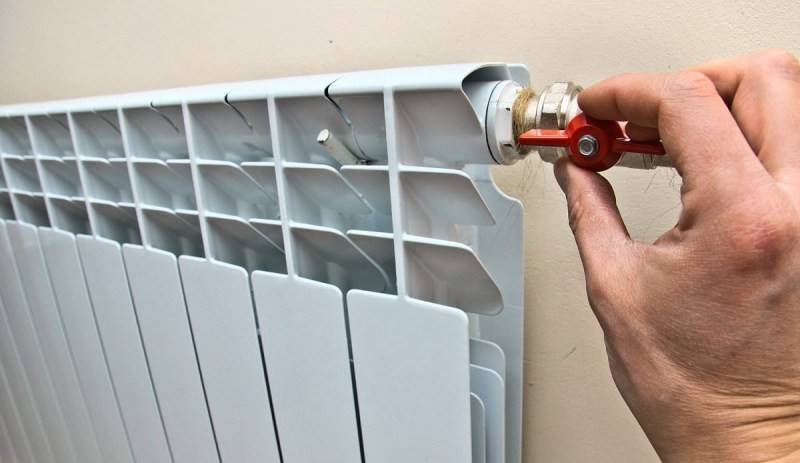

You see, if you follow the rules and carry out prevention, it is quite possible to minimize the likelihood of air jams in the heating system, which reduce the temperature regime in the apartment.
How to bleed air from a radiator using an air vent
Valves will help to release air from the radiators (they can be manual or automatic). Let's analyze their types.
Mayevsky crane
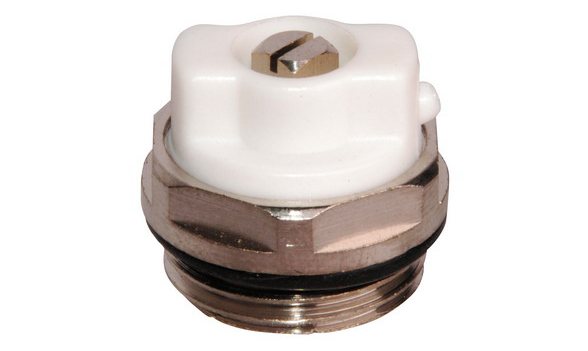

The needle valve, which is designed with a body and a tapered screw - are very tightly fastened together to prevent water leakage.
The tap has a side hole that allows you to bleed air from the coolant using a screwdriver or a key from the kit (in some models - manually). When installing the Mayevsky crane, you need to make sure that the tube through which the air is removed looks exactly down (but not into the wall!).
Note! An automatic air vent should be selected for a cast iron radiator.
So how do you bleed the air from the radiator? Follow the instructions below:
- Take a wrench or screwdriver, rag and place some container under the tap.
- Switch off the pump.
- Begin to gently turn the tap counterclockwise.
- The air from the radiator is unlikely to be clean.
- Close the tap after water flows out.
Note! If the system uses low-quality water, then shut-off valves will not be superfluous. First, a valve that prevents the accumulation of debris is installed, and then a faucet.
Automatic air vent
It helps to automatically release air from the coolant in case of accumulation. The air vent has a brass body, float, articulated arm and valve. The closure cap is sealed, the spring-loaded protection does not let debris into the system.
The principle of the system is as follows:
- Until it is necessary to bleed the air from the radiator, the valve is covered with a float.
- In order to release air from the radiator, the float opens the valve.
- As the gas is removed, the air vent returns to its original position.
Remember! The automatic air vent has a hole for an octagonal wrench or screwdriver, by means of which, in the event of a malfunction, the air from the radiator can be manually deflated.
Air separator
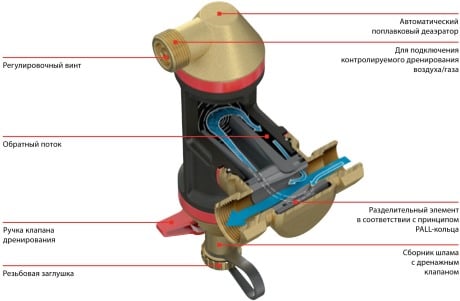

This device allows you to release air from radiators in stand-alone systems. An air separator removes the accumulated gas in the system, converting it into bubbles. The device is used in conjunction with a sludge separator that removes various contaminants from the water.
The system has the following form: a metal cylinder, on it there is an air outlet, under it is a valve for sludge discharge. In the inner part there is a metal mesh that creates vortex flows. Water passing through the system is filled with air bubbles that rise and exit through the air outlet. The remaining dirt is drained through the tap.
Knowing how to bleed air from the radiator will help prevent serious damage. Also, gas is removed for "prevention", you should do this twice (to make sure there is no gas). However, if there are malfunctions in the heating system, then it is necessary to bleed the air from the coolant several times.
Read the material on the topic: How to change a heating radiator without errors
Reasons for airing the system
There are several fairly common reasons that provoke the appearance of an air lock inside heating structures:
- depressurization that occurred during the implementation of scheduled preventive or repair work;
- incorrect flushing or pressure testing of the system, followed by filling the water circuit with a standard coolant;
- local violation of the integrity of pipelines and radiator batteries under negative external influences or as a result of maintenance and operation errors;
- in private households - the absence of a sufficient pipe slope and an expansion tank in the installed system;
- reduced pressure level in the water supply system, filling the formed voids with air;
- faulty condition of the air intake elements;
- connection to the heating structure of the "warm floor" system with pipes of different heights;
- air suction through leaking seam joints and joint areas;
- low quality of the coolant, its oversaturation with gases;
- replenishment of the volume of the heat carrier by adding cold tap water.
One of the most common problems is the presence of errors and inaccuracies at the stage of creating project documentation or installing piping.
Heating system without air pockets
To prevent air from accumulating in problem areas in an individual heating system, but to go outside, it is necessary:
- correctly design and install the pipeline, correctly install the radiators;
- use automatic and manual air vents.
Consider how to expel air from a heating system with natural circulation and top wiring
When arranging the pipeline, it is important to observe such an angle of inclination at which air bubbles move freely up to the highest point of the contour, without accumulating at turns and gentle sections. At the highest point of such a system, an open-type expansion tank must be installed through which air bubbles enter the atmosphere.
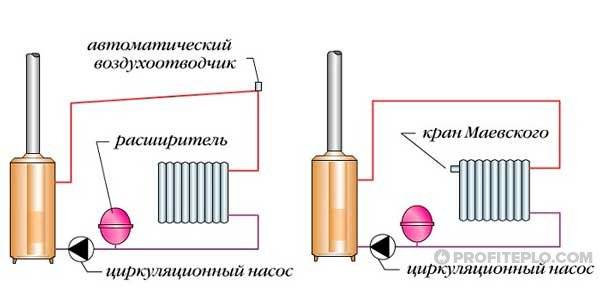

Bleeding air from the heating system using an automatic air vent
A different principle is used to bleed air from a forced movement system or a gravity system with a bottom wiring.
... Return pipelines are installed under a slope (this simplifies the drainage of fluid from the system), and automatic valves are installed at the top of all individual circuits, through which air is discharged as it accumulates.
In addition to automatic air vents, the system also uses Mayevsky's manual taps. Such air vents are mounted on heating radiators - on the upper branch pipe on the opposite side of the pipe supplying the heated coolant. In order for air to enter the valve, and not accumulate in the upper radiator manifold, it is recommended to install the heating device at a slight angle. Air venting is done manually as needed.
How to find an airlock?
Ideally, the system is able to cope with the airing on its own thanks to the automatic valves through which the air is released. Having found that a separate heating device or part of the circuit does not work properly, it is necessary to find a place where an accumulation of air has formed.
Touch the radiator - if its upper part is colder than the lower one, it means that the coolant does not enter there
... To release the air, open the Mayevsky tap mounted on a steel, aluminum or bimetallic radiator, or a valve tap mounted on cast iron batteries.
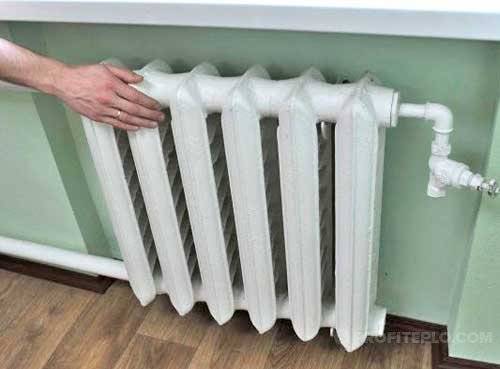

How to identify an airlock in a battery
You can also determine the place of airing by sound - under normal conditions, the coolant moves almost silently, extraneous gurgling and overflow sounds occur due to an obstacle in the flow
.
Metal pipes and heating devices are tapped with light blows - in places where air accumulates, the sound is noticeably louder.
Getting rid of the airlock
If there are manual air vents on the radiators, there are no problems with how to remove air from the batteries. Using a screwdriver or a standard key, the stem of the Mayevsky valve is slightly unscrewed, while a suitable container is placed under the drain hole (a half-liter glass jar is enough). Bleeding air from the heating system using a manual air vent is accompanied by hissing and whistling, then splashes appear, after which the coolant begins to flow in a thin stream. At this stage, the Mayevsky valve should be closed.
To remove an air lock from the heating system, if it has accumulated on the side of the air vent (manual or automatic), proceed as follows
:
- Open the air valve or valve closest to the air bubble.
- They begin to gradually feed the system with a coolant so that the liquid, by increasing the volume, displaces the air bubble towards the open air vent.
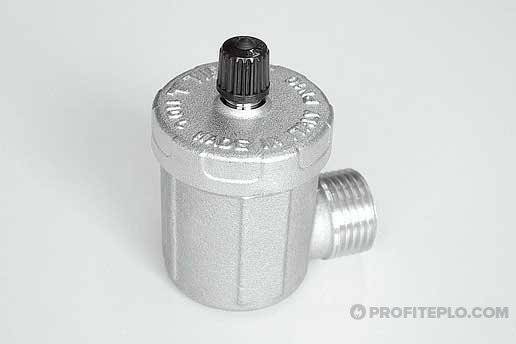

Automatic air vent valve with angle connection
What to do in difficult cases when the plug is not removed by adding the volume of the coolant? In such a situation, in addition to increasing the amount of coolant, it is required to add pressure, heating the liquid to critical temperatures. You should be extremely careful not to be scalded by splashes that accompany the air release through the automatic valve.
Installation of the Mayevsky crane
To solve the problem once and for all, you will need to install a Mayevsky crane. For these purposes, it is necessary to purchase a foot that is installed in place of the plug and has a thread for screwing in the tap.
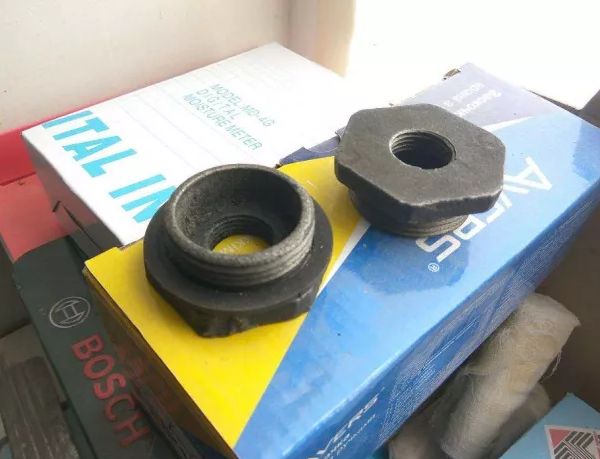

Futorka
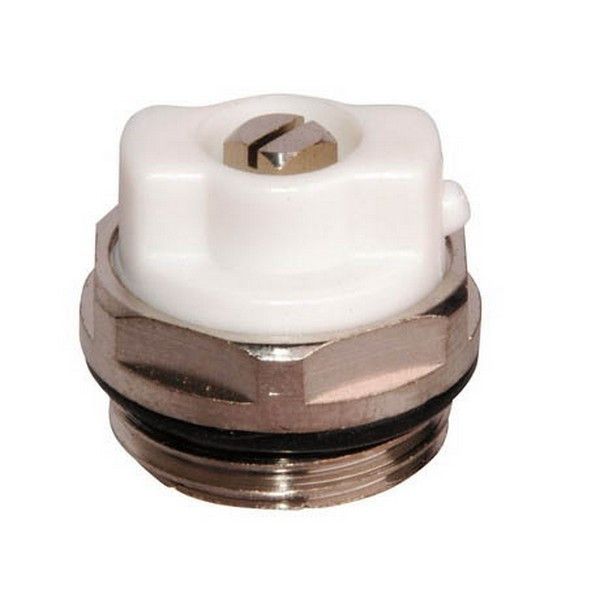

Mayevsky crane
The procedure itself is as follows:
- Cut off the battery from the general supply of the coolant using the installed taps. If there are none, then you will need to drain the coolant from the system - in private houses this is quite simple, but in apartments you will have to contact the appropriate organization to agree on such events.
- Unscrew the plug as described in the first section of the article.
- Clean the thread from dirt, make sure it is intact. If the grooves are "licked off" - perform a thread cut with a tap.
- As a sealant, wrap a small amount of flax or fum tape around the threads.

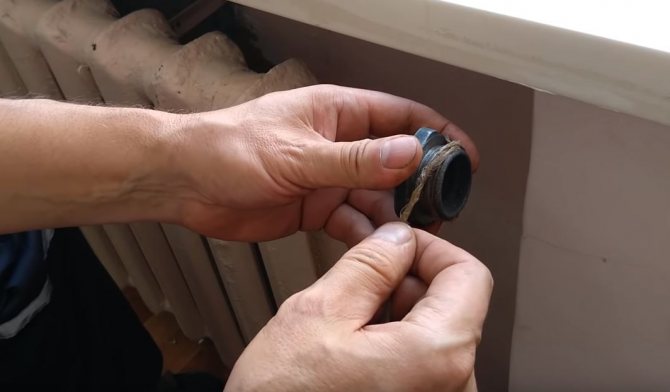
Winding flax on a shoe - Screw in the foot, then install the Mayevsky tap on the cast-iron battery.

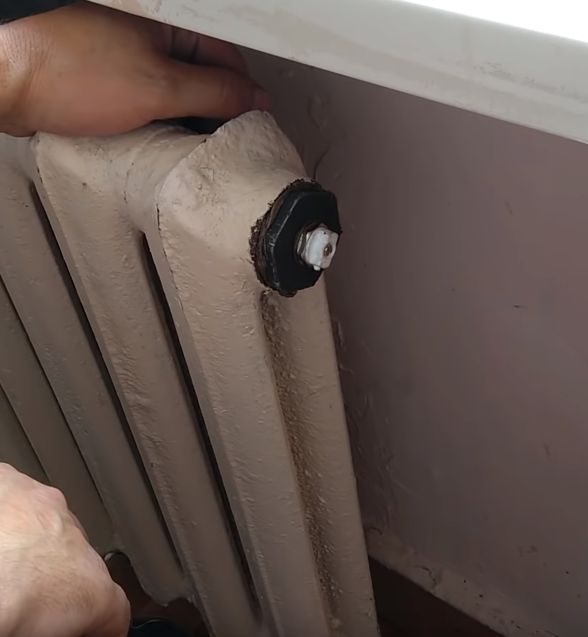
Installed Mayevsky crane - Fill the system with water and check for leaks.
Video on installing the Mayevsky crane:
It is very simple to use the valve for venting air, just remove the protective cap and use a screwdriver to unscrew the valve until a characteristic whistle appears. If water immediately flows from the outlet, it means that the radiator is completely filled with coolant.There are several reasons why the battery stays cold after deflating.
Acting in accordance with the recommendations presented, it will be possible to deflate the cast-iron battery. Unscrewing the plug is suitable if the radiator is relatively new and the connections have not yet had time to "stick" to each other. Drilling a small hole is suitable even for old batteries that cannot be disassembled.
Share this:
Methods for removing air from hot water heating systems
Since heating can be both natural and forced circulation of the coolant, the air in the heating system can also be removed in different ways.
For systems with natural circulation (top piping is considered), the air lock can be removed through the expansion vessel, which should be at the highest point relative to the entire system.
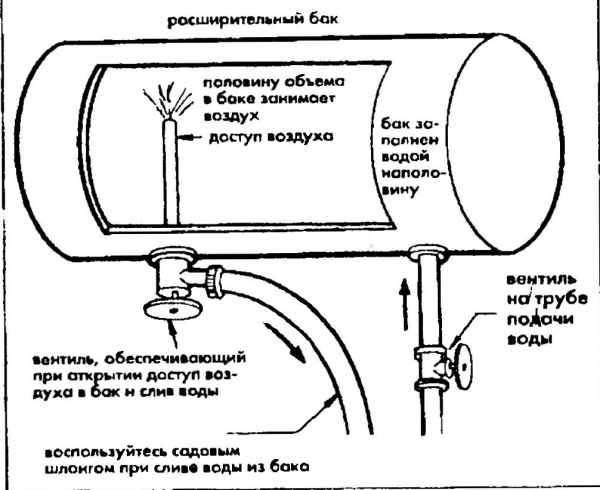

Removing air through the expansion tank. Click to enlarge.
The supply line should be laid with a rise towards the tank. If the wiring is lower, it is necessary to provide for air removal in the same way as in a heating system with a circulation pump.
For systems with forced circulation, an air collector should be provided - at the highest point, which will be responsible for air release.
In this case, the supply pipeline is laid with a rise in the direction of movement of the coolant, and air bubbles, rising along the riser, are removed from the heating system through air taps, which must be installed at the highest point.
In any case, the return pipelines should be laid with a certain slope - towards the water drain in order to speed up the emptying of the pipes during repair work.
In closed-type heating systems, automatic air vents are provided - they are installed at several points along the pipeline, the air from which is discharged separately.
If the installation of the heating system and the laying of pipes at the required slope are done correctly, then bleeding through the "air vents" will be simple and not entailing any problems.
I would like to note that the removal of air from the pipes is accompanied by an increase in the flow rate of the coolant and an increase in pressure in them. In the case of airing heating batteries, there may be poor tightness of heating pipelines or uneven temperature differences.
Very often, in residential buildings equipped with an autonomous boiler with an open heating system, water can be discharged directly through the expansion tank: after emptying, it is advisable to wait at least half an hour and only then open the "air vent" on the tank - all the air will go out on its own when the water temperature in the system rises ...
Types of bleeding mechanisms
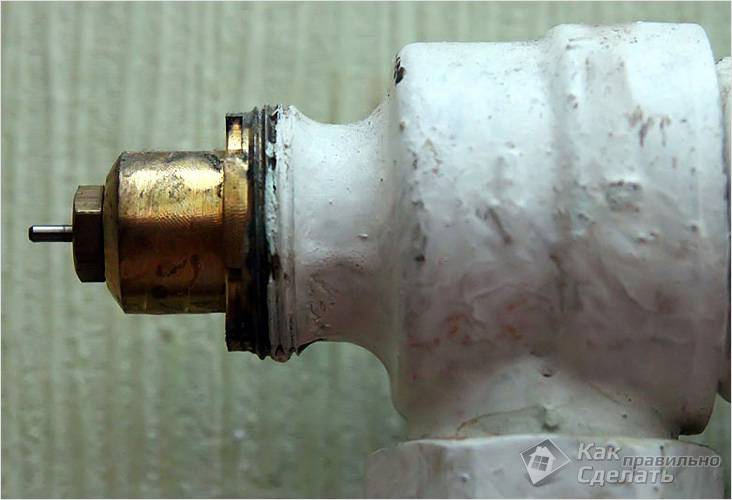

Battery valve
Known mechanisms used to remove air from heating systems are usually divided into manual and automatic. Hand-held devices (or Mayevsky taps) are small in size and are usually installed on the end cut of the radiator. The valve is controlled when bleeding air with a special key, a simple screwdriver, and sometimes manually.
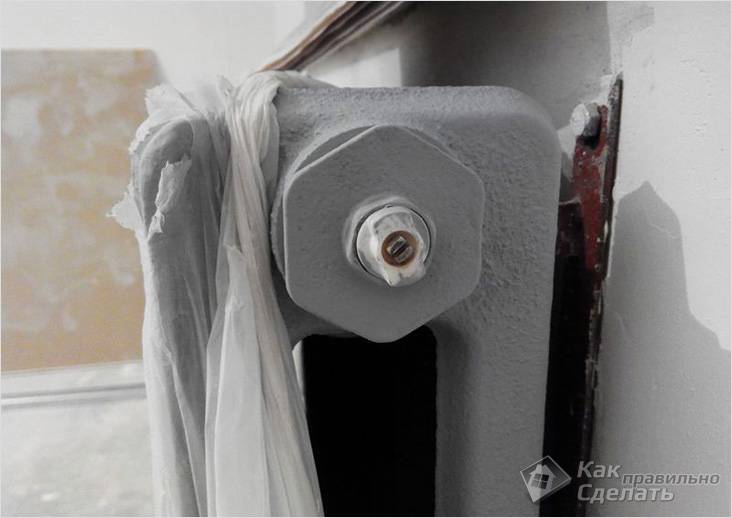

You can use a flat screwdriver
Bleeding air using the Mayevsky valve should be carried out after the coolant in the system has completely cooled down (that is, when the batteries are cold). Due to their small size, Mayevsky's devices do not differ in high performance and are usually used only to eliminate local malfunctions.
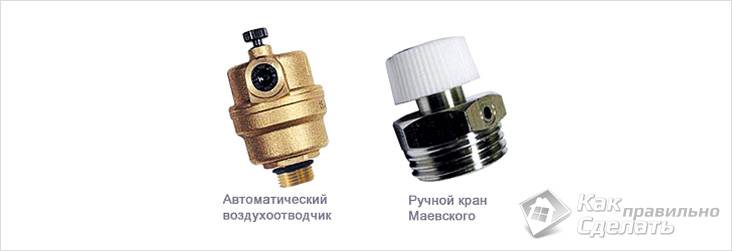

The ways
Automatic air vents are used in closed-type heating systems and work without direct human intervention.Distinguished by high performance, they are quite sensitive to the content of impurities in the coolant and are mounted together with filters installed both on the supply and return branches of the heating system.
To increase the efficiency of automatic bleeding systems, they are made in multi-stage, which provides the possibility of separate air discharge in each group of devices. In the event that the pipes are mounted with a slight slope in the direction of movement of water, the release of air in them is accompanied by an increased flow rate of the coolant, which, as a rule, leads to a gradual increase in pressure in the system.
Reasons for the formation of air congestion
For efficient heating of your home, it is necessary to remove air "plugs" in a timely manner.
"Blockage" or an air lock can form in pipelines if:
- The heating system was being repaired - during the repair work, the appearance of air is inevitable.
- When laying and installing pipes, the required slope and its direction were not observed.
- Pressure drops - since the water level in the pipes drops over time, the pipelines are emptied, filling with air.
- A heating system with natural circulation of the coolant has been installed (in private houses of small areas, heating is arranged without forced circulation, i.e., a circulation pump is not installed). In this case, airing of the heating system occurs due to a possible pressure drop in the pipes.
- The coolant leaks through poorly sealed pipe joints. It is quite difficult to notice a leak if the flaw is small (for example, the connection is not very tight), and hot water can flow and immediately evaporate.
- The heating system does not fill up correctly after a long shutdown (in autumn) Some homeowners strive to fill the pipes with water quickly and "to capacity", but this is wrong. Filling should be done slowly while removing air from the heaters and distribution pipes.
Air can also enter the pipes directly with the coolant - as you know, there is some content of air bubbles in the water, which rise up when the temperature of the water rises.
In houses where water “warm floors” are also connected to the common distribution manifold, it is also possible to observe the formation of an air lock in the heating system.
The reasons are almost the same, but the elimination of this problem is quite problematic, since the pipes are unevenly located in their height. Hence the conclusion: it is necessary to constantly monitor the pressure and flow rate of the coolant in the pipes or install air collectors (they are also called "air vents").
Reasons for the appearance of air in batteries
With the beginning of the heating season, some residents of apartment buildings and owners of their own cottages are asking themselves a problem: how to release air from the heating battery?
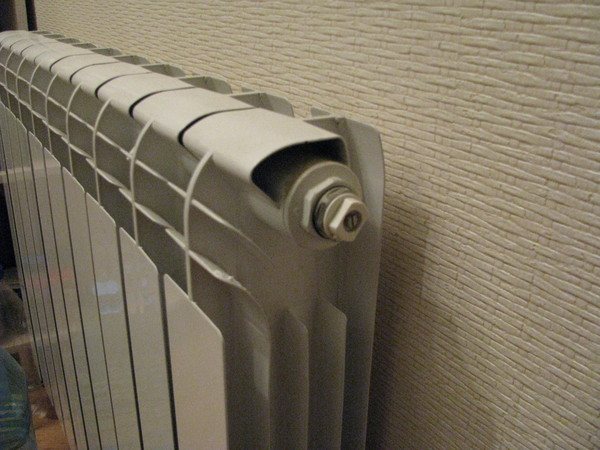

How to properly bleed air from a battery
The need for this arises from the uneven heating of the premises. After the start of the heating season, it becomes noticeable that some batteries heat well, and some remain cold in whole or in half. Cold radiators and noises in them are signs of the formation of air jams, the reasons for which are:
- lack of proper pressure in the heating system, which in itself leads to its incorrect operation. The pressure decreases when the coolant leaks through poorly sealed seams;
- production of low quality radiators, non-compliance with standards in their manufacture;
- performance of poor-quality repair work - non-observance of the directions of the slope of the pipeline mains;
- improper filling of the heating system with water - filling should be carried out with simultaneous air release, it can only be drained at a slow pace;
- low quality of water in the heating system - too hard water does not allow the system to work correctly, the optimal hardness is 5–7 mg / eq / l.
How to get rid of an airlock
Unfortunately, the airlock is not always in an easily accessible place. In the event of design or installation errors, air can accumulate in the pipes. Bleeding him out of there is very difficult. First, we determine the location of the plug. In the place of the plug, the pipes are cold and a murmur is heard. If there are no obvious signs, they check the pipes by sound - they tap on the pipes. In a place where air is accumulated, the sound will be louder and louder.
The found airlock must be expelled. If we are talking about the heating system of a private house, for this, the temperature and / or pressure is raised. Let's start with the pressure. The nearest drain valve (in the direction of movement of the coolant) and the make-up valve are opened. Water begins to flow into the system, raising the pressure. It forces the plug to move forward. When air enters the vent, it comes out. Stop making up after all the air is gone - the drain valve will stop hissing.
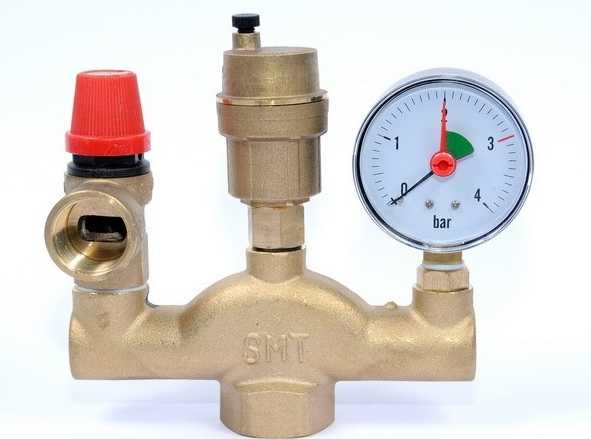

This is a security group. An automatic air vent is installed at the middle outlet
Not all air locks give up so easily. For extra stubborn, it is necessary to simultaneously raise the temperature and pressure. These parameters are brought to values close to the maximum. You cannot exceed them - it is too dangerous. If after that the plug has not gone away, you can try to open simultaneously the drain valve (to drain the system) and the make-up valve. Maybe this way it will be possible to move the airlock or get rid of it altogether.
If a similar problem occurs constantly in one place - there is an error in the design or wiring. In order not to suffer every heating season, a valve for air exhaust is installed in the problem area. A tee can be cut into the line and an air vent can be installed on the free inlet. In this case, the problem will be solved simply.
Reasons for the formation of air congestion
Getting rid of air in the system
Why does air appear inside a sealed heating system? This can happen due to:
- Failure to comply with the standard for the direction of the slope and the places of bends of the main pipelines during installation work.
- Incorrect filling of the entire system with water.
- Loose connections of various components and elements that contribute to the suction of air from the external environment.
- Incorrect operation of the air vents or their absence.
- Carrying out repair work to replace risers, locking mechanisms, heating devices, as a result of which air enters the heating system
- Using fresh water to refill the system. Cold water contains a fairly large amount of dissolved oxygen. As the temperature rises, its concentration in water decreases significantly. The air from the coolant is released by small bubbles, which rise and are collected by an air lock at the extreme upper points of the heating system and radiators.
Why is an airlock in a radiator dangerous?
If an air vent appears in the battery, nothing good will come of it. Excess air is an obstacle to the normal functioning of the system. It can also cause corrosion on the radiator walls.
If a circulation pump is installed in the circuit, an air lock can disrupt its operation. When the system is functioning correctly, the sleeve bearings on the shaft of the pump unit are constantly in the water. And in the presence of an air supply, the effect of "dry friction" occurs, which negatively affects the sliding rings, and can damage the shaft. Therefore, it is important to know how to expel air from the home heating system. Measures taken in time will help prevent damage to the heating network.
Installation of air vents
At all upper points of the system, be it pipe bends or radiators, air vents need to be installed - the main tool in the fight against congestion. The air vent can be automatic (valve) or manual (Mayevsky valve). The automatic valve will do everything by itself, unnoticed by the owner.
In order for the automatic air release valve to work properly, you need to make sure that the coolant is clean all the time.
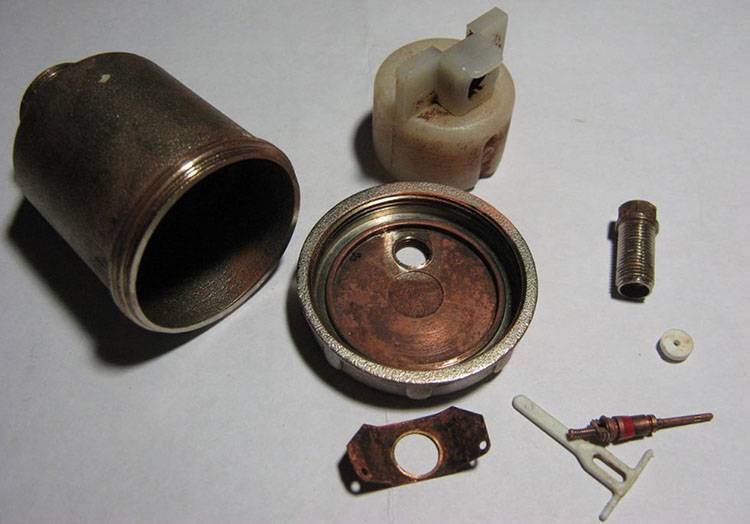

Internal structure of the automatic air vent
In manual mode, if signs of airiness appear (decrease in temperature in the area, gurgling, drop in pressure), you need to immediately take care of the release of air.
When replacing a radiator, they buy a mounting kit, which has everything you need for installation, including the Mayevsky crane. But air vents are sold separately. They are placed in the upper radiator nozzle, on the opposite side from the supply inlet.
Installing air relief valves
To remove air from the heating, air vents are installed on the radiators - manual and automatic air valves. They are called differently: a vent, an air vent, a bleed or air valve, an air vent, etc. The essence does not change from this.
Mayevsky air valve
This is a small device for manually bleeding air from heating radiators. It is installed in the upper free radiator manifold. There are different diameters for different sections of the collector.
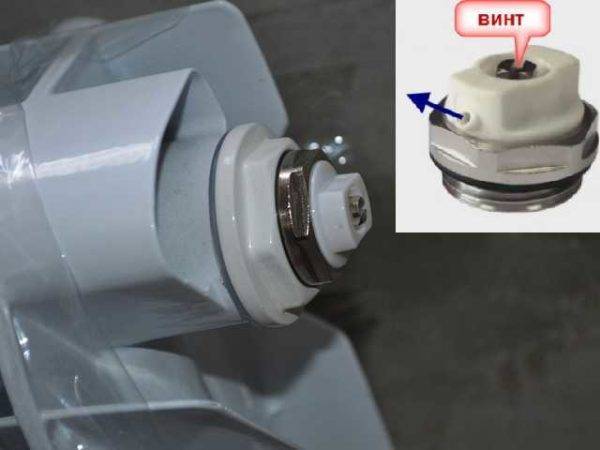

Manual air vent - Mayevsky crane
It is a metal disc with a conical through hole. This hole is closed with a tapered screw. By unscrewing the screw a few turns, we provide an opportunity for air to escape from the radiator.
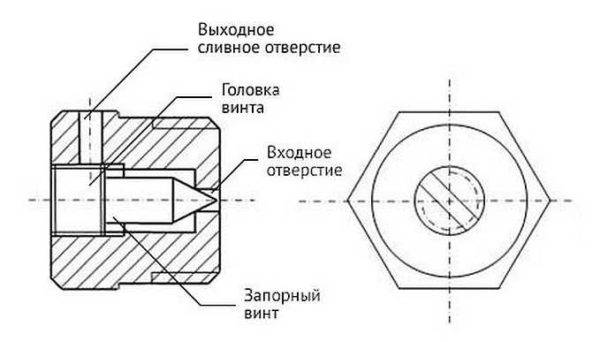

Device for venting air from radiators
To facilitate the air outlet, an additional hole is made perpendicular to the main channel. Through it, in fact, the air comes out. While airing with a Mayevsky crane, direct this hole up. After that, you can unscrew the screw. Unscrew a few turns, do not twist too much. After the hissing stops, return the screw to its original position, go to the next radiator.
When starting up the system, it may be necessary to bypass all air collectors several times - until the air stops coming out altogether. After that, the radiators should warm up evenly.
Automatic air relief valve
These small devices are installed both on radiators and elsewhere in the system. They differ in that they allow you to bleed air in the heating system in automatic mode. To understand the principle of operation, consider the structure of one of the automatic air valves.
The principle of operation of the automatic escapement is as follows:
- In the normal state, the coolant fills the chamber by 70 percent. The float is at the top, presses the stem.
- When air enters the chamber, the coolant is displaced from the body, the float is lowered.
- He presses a ledge-flag on the jet, squeezing it out.
- The wrung out orifice opens a small gap, which is enough for the air that has accumulated in the upper part of the chamber to escape.
- As the water escapes, the air vent body fills with water.
- The float rises, freeing the stem. It is returned to its place by means of a spring.
Different designs of automatic air valves work according to this principle. They can be straight, angular. They are placed at the highest points of the system and are present in the security group. They can be installed in identified problem areas - where the pipeline has an incorrect slope, due to which air accumulates there.
Instead of Mayevsky's manual taps, you can put an automatic drain for radiators. It is only slightly larger in size, but it works in automatic mode.
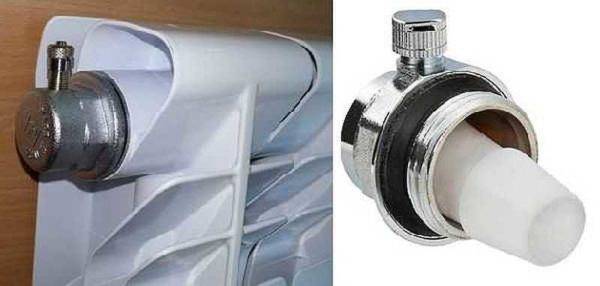

Automatic air vent for venting
Salt cleaning
The main trouble with automatic valves for venting air from the heating system is that the air outlet is often overgrown with salt crystals. In this case, either the air does not come out or the valve starts to "cry". In any case, you need to remove and clean it.
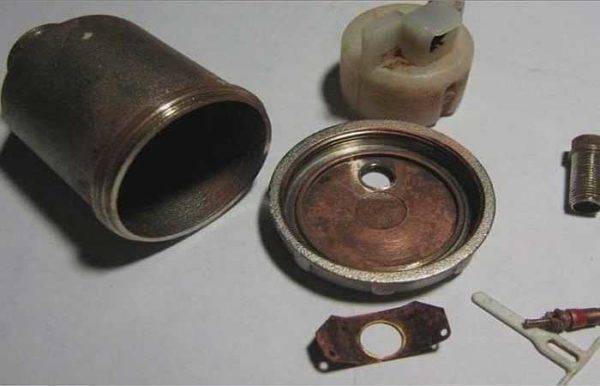

Disassembled automatic air vent
So that this can be done without stopping the heating, automatic air valves are paired with non-return ones. A check valve is installed first, an air valve is installed on it. If necessary, the automatic air collector for the heating system is simply unscrewed, disassembled (unscrewed the lid), cleaned and reassembled. The device is then ready to bleed air from the heating system again.
What radiator should you start bleeding from?
Depending on the layout of your home, it will depend on which radiator you start with. If you live in a two-story house, you will have to start with the radiators at the bottom first, starting with the radiator farthest from the boiler, and once you have done that, you can then go upstairs using the same method.
If you have any air in your radiator, it will go up to the top.
Radiator outlet valve location
There is a small square plug called a drain valve on one side of the radiator. Depending on how old your radiators are will depend on what type of descent you have.
If you have an older type of valve, you will need a special wrench to install this outlet valve (figuratively called a radiator outlet valve wrench) and can be purchased at most stores.
If you have a new type of valve, then the release valve wrench should match this as well, but if you don't have one you can use a flat head screwdriver (not ideal as you will have a little more control with the release valve wrench) ...
Loose drain valve
If you find that your vent valve is damaged and you cannot loosen it with a wrench or screwdriver.
In this case, you may need to loosen the large nut that surrounds the outlet valve using a suitable wrench or adjustable wrench. This can be quite difficult, so only resort to this if you have no other choice.
Holding your towel or cloth under the exhaust valve, turn the key counterclockwise about a quarter turn (old valve or screwdriver counterclockwise with new valve) and if there is air in it, you will hear a hissing sound from the radiator as it exits.
As soon as the hissing stops, water will flow out of the radiator, at this moment close the key or screw very tightly. You have now removed all the air from the radiator and can now move on to the next one.
Add water to the heating system
If your heating system is equipped with a combi boiler (or a boiler that needs to be refilled manually), you may need to refill it depending on how much water came out during the bleeding process and / or how much air was in the system.
If the hissing occurs for a long time before any water appears, this may mean that your system is low on water and needs to be refilled.
Different manufacturers may use different methods of charging their boiler systems, so please refer to any documentation that came with your boiler for how to do this.
Filling the system with water
- To begin with, we open all the taps (on both sides of the pump, on all radiators, on the collectors of the water floor, on the expander), and Mayevsky's taps are closed.
- The system must be filled from the bottom up. The inlet is made at the lowest part (through it, the coolant is drained and poured).
- From above, the main valve (at the highest point of the system) opens to release air and slowly fills. There is no need to rush, just so that the air can escape. The fluid supply remains open until water comes out of the valve.
- The system builds up the pressure recommended for it as a working one. Then, one by one, the air is vented from each radiator in the house (it's time to turn off the tap when the water runs in a trickle).
- There is a screw in the central part of the circulation pump, which is slightly unscrewed with a screwdriver. Air is bled from the pump, then twisted.
- After the air is vented, the pressure in the system will drop and it will be necessary to turn on the water supply again to make up for the losses.
- After that, a test run of the boiler is done at a low temperature (about 40 ° C), with the pump turned on. During this start-up, it is advised to bypass and look through all the elements of the system - if there is a leak, if air is coming out somewhere, if all radiators are warming up evenly. Then, you may need to add water again and then start the boiler into operating mode.
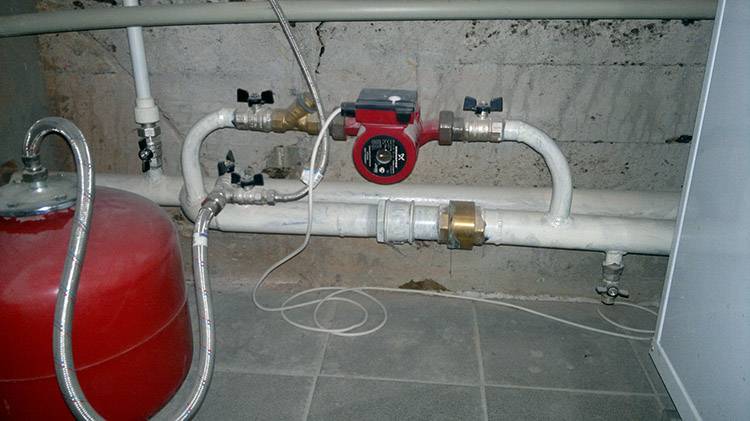

Filling the system with water
If suddenly one of the valves remains closed, and the system is already full and the pressure is high, you need to open the valve very slowly and carefully. Otherwise, you will get a decent water hammer.
Methods for removing an airlock from the cooling system
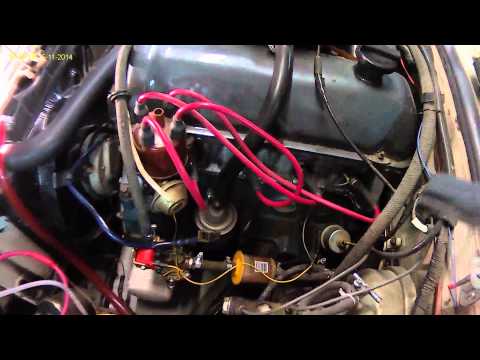

How to expel an airlock from the cooling system of a VAZ classic
There are three main methods by which an airlock can be removed. Let's list them in order. The first method is great for VAZ vehicles. Its algorithm will be as follows:
Remove from the engine any guards or other items that might prevent you from reaching the coolant expansion tank. Disconnect one of the nozzles that are responsible for heating the throttle assembly (it does not matter, direct or reverse). Remove the expansion tank cap and cover the neck with a loose cloth. Blow inside the tank. In this way, you will create a slight excess pressure, which will be enough for the excess air to escape through the nozzle. As soon as antifreeze comes out of the hole for the nozzle, immediately put the nozzle on it and, preferably, fix it with a clamp
Otherwise, air will enter it again. Close the expansion tank cap and reassemble all previously removed engine protectors.
The second method is carried out in accordance with the following algorithm:
- Start the engine and let it run for 10 ... 15 minutes, then turn it off.
- Remove the necessary elements in order to get to the coolant expansion tank.
- Without removing the lid from it, disconnect one of the nozzles on the tank. If the system has been airy, then air will begin to come out of it.
- As soon as the antifreeze pours out, immediately reinstall the pipe and fix it.
When doing this, be careful, since the temperature of the antifreeze can be high and reach a value of + 80 ... 90 ° C.
The third method of how to remove an air lock from the system must be done as follows:
Place the machine on a hill so that its front is higher
It is important that the radiator cap is higher than the rest of the cooling system. At the same time, put the car on the handbrake, or better place stops under the wheels. Let the engine run for 10 ... 15 minutes. Unscrew the caps from the expansion tank and radiator. Periodically press the accelerator pedal and add coolant to the radiator
In this case, air will escape from the system. You will notice it by the bubbles. Continue the procedure until all the air is gone. In this case, you can turn on the stove to the maximum mode. As soon as the thermostat opens the valve completely and very hot air flows into the passenger compartment, it means that the air has been removed from the system.At the same time, it is necessary to check for bubbles escaping from the coolant.
As for the latter method, on machines with an automatically switched on cooling system fan, you can not even over-gas, but calmly let the engine heat up and wait for the fan to turn on. At the same time, the movement of the coolant will increase, and the circulation will cause air to escape from the system.
In this case, it is important to add coolant to the system in order to prevent air bubbles again.
As you can see, the methods of how to get rid of an airlock in the engine cooling system are quite simple. They are all based on the fact that air is lighter than liquid. Therefore, it is necessary to create conditions under which the air lock will be forced out of the system under pressure. However, it is best not to bring the system to that state and take preventive measures in time. We will talk about them further.
Control methods
The circulation of the coolant can be either forced or "natural". You can also bleed air in different ways.
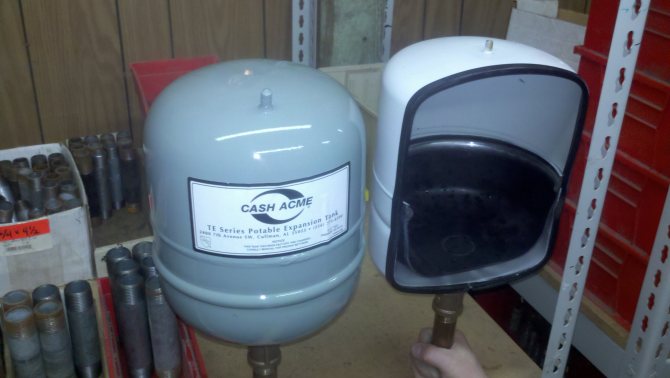

The expansion tank will help to eliminate the problem.
If the circulation is "natural", then the plug is removed by means of an expansion tank. You can find this tank at the highest system point.
How to properly bleed air from the system if the wiring is located at the bottom?
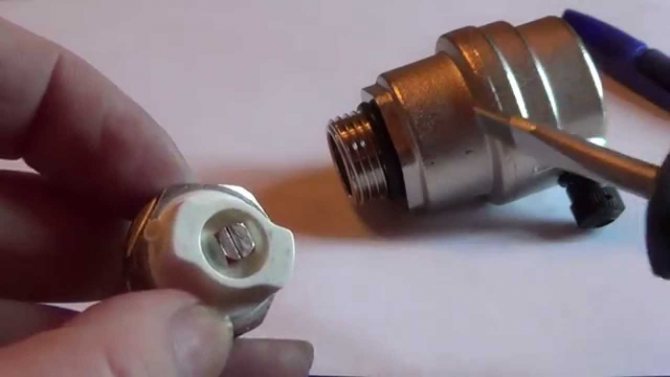

It is very convenient to use the self-timer
The elimination process is similar to the air release method for a circulating pump. An air collector must be used. It involves the discharge of accumulated air. Proper installation is very important. It involves the removal of excess air through a special riser. In this case, a special device is used - a self-release crane. It helps to release air quickly and efficiently.
The (return) pipeline must be laid with a slope. The right direction is to drain the water. This method is considered the fastest and easiest.
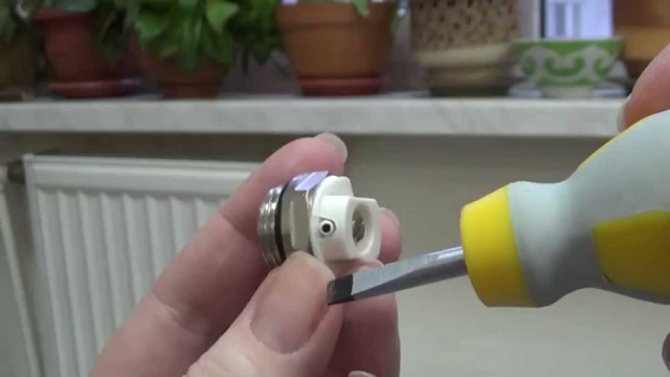

Bleeding air
How to get rid of an airlock in the heating system? You need to properly pump it. You need to expel the air like this:
- "Arm yourself" with a key (screwdriver).
- Prepare a large, deep container for water to drain.
- Open the thermostat.
- Open the valve.
- Substitute the container.
- Hold the valve open and allow water to drain out.
- Close the tap.
Why batteries do not heat well
Cold batteries
During the heating season, many radiators do not heat very much, so the room is cold and uncomfortable. There may be several reasons for this phenomenon.
The first is that air has accumulated in the battery. This is indicated by a characteristic gurgling sound. The radiator becomes partly cold due to insufficient circulation of the coolant. In such a situation, it is very easy to purge the battery. If an aluminum radiator is installed with a thermostat, it is enough to open it completely and bleed the air. If there is no thermostat, open the Mayevsky tap or plug.
When opened through the hole, air will be blown out with a strong hiss. It must be vented until all of it comes out and water flows. Its uniform jet will indicate that the airlock has been eliminated and the radiator can be operated normally. On cast iron radiators, special valves are used to bleed air.
The second reason for poor circulation of the coolant is not air, but a dense plug of scale and large particles that run through the heating system along with hot water
Experts pay attention to the fact that even a millimeter thickness of scale deposits reduces the heat transfer of the battery by 15%. Therefore, it is advisable to purge the system before the start of each season and do it correctly.
How to understand that the accumulated scale is the reason for the ineffective operation of heating devices in the apartment? You need to pay attention to the following signs:
- The walls are covered with limescale if the riser is hotter than the radiator.
- Feel the radiators in all rooms in the apartment. Their different intensity of heating is a reason for "treatment".
- Uneven heating of sections of one battery.
What methods are there to fix these problems?
How do you know if there is an airlock in the battery?
Before releasing air from the heating system, you need to figure out why it is formed in the circuit and how to understand that there is an air lock in the radiator. Most often, excess air accumulates as a result of improper filling of the system with water. The reason may also be the result of mistakes made during installation. Low pressure in the circuit, low-quality heat carrier with the presence of dissolved oxygen can also lead to airing.
An airlock can also occur under the following circumstances:
- The components of the system are not tightly connected. As a result, air from the outside is sucked in by the battery.
- There is no air vent or it is present, but it does not work correctly.
- Repair work was carried out to replace locking mechanisms, risers, heating devices, during which air entered the system.
The following signs may indicate that excess air has accumulated in the system: hissing and gurgling sounds in the battery, the quality of heating decreases, heating becomes uneven, the radiator may be cold in areas where air is present.
Such situations are not uncommon. Surely every owner of an apartment or private house has faced a similar problem. Therefore, it is important to figure out how to remove air from the heating system of a house, especially since it is not at all difficult to do it yourself. It should be noted that most often an airlock forms in the batteries that are installed on the upper floors of the house.
Important! Sometimes the cause of plugging is a poor quality radiator.
In this case, no matter how much excess air is released, it will form again. And the reason lies in the fact that the material from which the battery is made contributes to the formation of gases. There is only one way out of the situation - to buy a new radiator. Therefore, it is better to immediately purchase heating devices from bona fide manufacturers.
